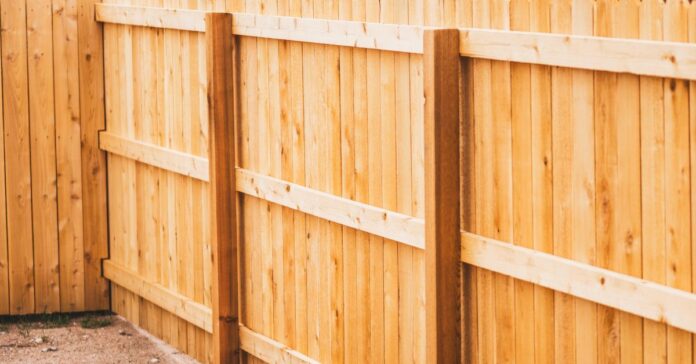Last Updated 1 day ago by Kenya Engineer
Looking for a fence that’s both sustainable and stylish? Discover eco-friendly fencing solutions that not only boost your property’s curb appeal but also reduce your carbon footprint. Ready to make a green choice that’s both practical and eco-conscious?
As environmental awareness grows, property developers are increasingly turning to sustainable solutions to minimize their carbon footprints, and eco-friendly fencing stands out as an ideal choice. By opting for materials that conserve resources and enhance the visual appeal of a property, developers can reduce their environmental impact while improving curb appeal. Whether it’s providing security, privacy, or even shielding electrical cables from exposure, these green fencing options offer versatility for residential and commercial spaces. Composite fencing, for example, combines recycled wood fibers and plastics, offering a low-maintenance, durable, and eco-conscious alternative to traditional wood. Sustainable designs not only protect the environment but also elevate property value, making them a smart long-term investment.
Why Choose Eco-Friendly Fencing for Your Property?
Eco-friendly fencing offers numerous benefits for both residential and commercial properties, making it an appealing choice for those who prioritize sustainability. Sustainable fencing materials, such as bamboo, recycled wood, and recycled plastic, require significantly less energy to produce, resulting in a lower carbon footprint. These materials not only have environmental benefits but also contribute to reducing long-term costs for property owners. For instance, eco-friendly fences are typically more durable and require less maintenance compared to conventional options, leading to reduced repair and replacement expenses.
Moreover, these fences are often made from natural, aesthetically pleasing materials that integrate well into the surrounding environment, enhancing the overall appeal of the property. By choosing eco-friendly fencing, property owners promote environmental responsibility while improving the property’s aesthetic value and longevity. With sustainability, durability, and visual appeal in mind, let’s explore some of the most effective eco-friendly fencing materials that balance functionality with environmental responsibility.
Bamboo Fencing: Sustainable and Stylish
Bamboo is a top-tier sustainable fencing material, offering impressive benefits that make it a smart choice for both residential and commercial properties. Bamboo matures in 3–5 years and can grow up to 3 feet daily, providing rapid renewability. Compared to hardwood harvesting, its cultivation can cut emissions by ~60%, while root systems stabilize soil and enable repeated harvests without replanting—supporting long-term ecological balance and reliable material supply. Bamboo’s strength and durability ensure long-lasting performance, resisting the elements better than many other materials. Additionally, it naturally resists pests and rot, making it ideal for outdoor use in various climates.
Specify FSC-certified bamboo to verify responsible sourcing and chain-of-custody. Projects often earn LEED credits for rapidly renewable materials. Laminated and treated bamboo improves dimensional stability and decay resistance. The tensile strength comparable to mild steel supports slim, elegant profiles without compromising wind performance or longevity in coastal and temperate climates.
EcoVista Residential Estate (California) used oil-finished bamboo screens with borate treatment, achieving a 25-year design life and consistent color retention. Prefabricated modules reduced installation time by ~20% and minimized jobsite waste. Designers achieved warm, biophilic aesthetics aligned with wellness goals and HOA guidelines for privacy and streetscape harmony.
✓ Best for: Urban and residential spaces seeking natural aesthetics, renewability, and minimal maintenance.
Recycled Wood Fencing: A Sustainable Choice
Recycled wood is a compelling, eco-friendly fencing material that offers both sustainability and visual appeal. Reclaimed boards from barns, pallets, and decommissioned structures deliver 80–100% salvaged content. This preserves stored carbon and avoids milling emissions. Distinct patinas and grain character create bespoke visuals, while structural grading and selective replacement maintain integrity and wind-load performance for perimeter and courtyard applications. Recycled wood is also a powerful tool in waste reduction, contributing to a circular economy by giving new life to discarded materials.
Look for FSC Recycled certification to validate provenance. Reuse supports LEED credits for recycled content and waste diversion. Pre-finishing with low-VOC sealers extends service life and reduces maintenance intervals. Where needed, concealed steel stanchions add stiffness without diminishing the reclaimed aesthetic or increasing visible material intensity.
The Timberline Development Project (Oregon) installed reclaimed cedar fencing, cutting procurement costs by 30% and lead times by 25%. Factory-applied natural oil finish reduced onsite coating labor. The rustic look complemented native landscaping, meeting local design review requirements while diverting significant volume from regional wood waste streams.
✓ Best for: Projects that want warmth, character, and authenticity while contributing to forest conservation.
Vinyl Fencing Made from Recycled Materials
Vinyl fencing made from recycled materials presents a sustainable alternative to traditional vinyl, combining environmental responsibility with long-lasting performance. Recycled PVC formulas convert bottles, packaging, and offcuts into durable fence members, diverting thousands of pounds of plastic from landfills annually. Co-extruded skins improve UV stability and impact resistance. Closed-loop scrap recovery in fabrication facilities further reduces waste and material costs for developers and HOAs. Available in a range of colors and designs, recycled vinyl easily complements diverse property styles.
Zero- or low-VOC powder topcoats replace solvent systems, improving installer safety and air quality. Many suppliers publish EPDs and follow ISO 14001 environmental management. Typical service life exceeds 30 years, with colorfastness warranties and reparability via modular components that simplify damaged-picket replacement.
GreenEdge Estates (Texas) deployed 100% recycled PVC fencing community-wide, lowering annual maintenance by 40%. Uniform profiles satisfied architectural controls, and concealed fastener systems improved tamper resistance. End-of-life takeback agreements supported circularity goals, ensuring materials reenter production rather than burden municipal disposal streams.
✓ Best for: Developers seeking low-maintenance, long-lasting fencing with a polished, modern appearance.
Living Fences: Integrating Nature with Functionality
Living fences, also known as green fences or hedges, combine the beauty of nature with practical functionality, making them a top eco-friendly option. These fences utilize shrubs, trees, or climbing plants strategically planted to form a natural boundary that absorbs CO₂, filters particulates, and cools microclimates. Proper species selection can reduce ambient noise by up to 10 dB. Permeable, vegetated edges also manage stormwater and soften hardscape, increasing pedestrian comfort and neighborhood appeal.
Projects can pursue BREEAM, LEED SSc Rainwater Management, and biodiversity credits with native, pollinator-friendly species. Drip irrigation and mulch reduce water use by 20–40%. Structural trellis systems provide immediate screening while plantings establish, enabling phased growth with predictable performance and maintenance schedules.
London’s GreenWall Residential Project used ivy-clad screens to raise pollinator counts and improve thermal comfort along pedestrian paths. Maintenance plans prioritized seasonal pruning and integrated pest management. The project achieved BREEAM Excellent, documenting biodiversity net gain and measurable air-quality improvements adjacent to busy corridors.
✓ Best for: Eco-conscious homeowners and urban planners looking to combine privacy, biodiversity, and natural beauty.
Metal Fencing with Recycled Materials: Durability Meets Sustainability
Metal fencing made from recycled materials offers a robust, eco-conscious solution for both residential and commercial properties. By utilizing recycled steel, aluminum, or iron, property owners help reduce the demand for new metal production, which involves significant energy consumption and environmental impact. Recycled steel or aluminum delivers 50+ year lifespans with minimal upkeep. Producing steel from scrap saves ~74% energy and cuts ~86% CO₂ versus virgin routes. Aluminum recycling saves ~95% energy, dramatically shrinking embodied carbon while maintaining excellent corrosion resistance and structural reliability.
Specify ISO 14001 manufacturers and powder coats for durable, VOC-free finishes. Hot-dip galvanizing with controlled bath chemistries extends service life in coastal zones. Many suppliers provide EPDs and Declare labels, supporting transparent material inventories and compliance with public procurement sustainability criteria.
GreenSquare Commercial Park (New York) installed modular recycled-steel panels with 95% post-industrial content, reducing embodied carbon by ~40%. Quick-fit hardware cut labor hours by ~18%. The system met LEED Gold targets while withstanding high pedestrian traffic and snow loads without repainting during the first operating cycle.
✓ Best for: Commercial and high-traffic areas prioritizing longevity, strength, and sustainability.
Green Fencing and the Future of Sustainable Developments
The future of fencing across commercial and residential sectors is shifting toward sustainability as awareness of climate change drives property owners to integrate greener practices. Emerging bio-composites blend plant fibers with low-carbon resins, achieving high stiffness-to-weight ratios. Advanced manufacturing, including 3D-printed recycled polymers, allows on-demand parts, reducing overproduction. Electrified fabrication powered by renewables further decreases scope 2 emissions, moving projects toward net-zero construction objectives.
Novel inputs—hemp fibers, algae-derived binders, and recycled mineral fillers—target up to 70% emission reductions against conventional baselines. Digital twins forecast durability and maintenance, optimizing replacement cycles. Public incentives and green procurement policies accelerate adoption across municipal, educational, and multifamily developments.
Early pilots show mass customization without sacrificing performance. Prefabricated, repairable modules support circularity, enabling disassembly and remanufacture. Material passports track composition for future recovery. These practices align with LEED, BREEAM, and EN 15804 frameworks, turning fences into durable, upgradeable building components.
✓ Best for: Forward-thinking developers aiming to align with next-generation sustainable construction trends.
Eco-Friendly Fencing Made from Recycled Plastic Lumber
Recycled plastic lumber has emerged as an innovative, eco-friendly alternative to traditional fencing materials. This material comes from post-consumer plastics, such as bottles and bags, which turn into durable, low-maintenance fencing boards. Recycled HDPE/LDPE converts milk jugs and bags into rot-proof members impervious to moisture and termites. Dimensional stability reduces warping in humid climates. With UV inhibitors, service life often exceeds 50 years, outperforming treated wood in coastal and splash-zone conditions without preservatives.
Plastic lumber requires no painting or sealing, shrinking maintenance budgets. Many manufacturers publish EPDs and operate takeback programs, closing loops at end-of-life. Slip-resistant textures and concealed fasteners improve safety and appearance for boardwalks, pool enclosures, and beachfront properties exposed to salt spray.
Seaside EcoHomes (Florida) adopted recycled plastic fencing, reducing annual labor by 60% and eliminating solvent coatings. Prefinished tones mimicked weathered cedar, satisfying neighborhood design guidelines while delivering long-term resilience during hurricane seasons and high humidity periods typical of Gulf Coast environments.
✓ Best for: Coastal and residential projects requiring ultra-low maintenance and weatherproof durability.
Chain-Link Fencing with Eco-Friendly Coatings
Chain-link fencing, traditionally viewed as an industrial option, can be made more eco-friendly with the use of sustainable materials and coatings. For example, powder coating offers a non-toxic, durable finish that resists corrosion without relying on harmful chemicals. Modern chain-link uses recycled steel wire and non-toxic powder or thermoset coatings, replacing solvent-heavy systems. These coatings enhance corrosion resistance, extending the lifespan of the fence to up to 25 years with minimal need for repainting. Additionally, the open-mesh design of chain-link fences supports Crime Prevention Through Environmental Design (CPTED) principles while ensuring secure perimeters around utilities and logistics yards.
Galvanizing baths controlled for emissions, plus ISO 14001 processes, reduce environmental impacts. Modular gates and privacy slats allow upgrades without replacement. Many jurisdictions accept chain-link where permeability, surveillance, and airflow are critical, balancing cost effectiveness with operational requirements for safety and durability.
EcoLogix Industrial Park (Illinois) standardized powder-coated chain-link, cutting repaint cycles by 80% and ensuring visual uniformity. Rapid installation minimized downtime for tenants. Recycling contracts returned decommissioned sections into the steel stream, supporting circular material flows and corporate sustainability reporting.
✓ Best for: Industrial and commercial spaces needing cost-effective, secure, and eco-safe fencing.
Green Fence Panels with Recycled Glass and Concrete
Green fence panels made from recycled glass and concrete provide a sustainable, visually striking alternative for modern fencing needs. Glass-infilled concrete panels incorporate 30–40% post-consumer cullet, reducing virgin aggregate use and landfill burden. Light-diffusing surfaces provide privacy while preserving daylight. Reinforced mixes meet wind and impact criteria, enabling slim sections and elegant, contemporary streetscapes in dense urban contexts.
Supplementary cementitious materials—fly ash, slag, or calcined clays—lower binder emissions. Manufacturers often provide EPDs and HPDs, supporting material transparency. Anchoring systems allow plant-integrated facades, pairing panels with vines to improve microclimate, habitat value, and visual softness at pedestrian edges.
UrbanVista Apartments (Toronto) installed recycled-glass panels, diverting 18 tons of waste and improving nighttime illumination with embedded reflectance. Combined with native climbers, the boundary achieved privacy targets and reduced heat gain along walkways, supporting resident comfort goals during summer peaks.
✓ Best for: Contemporary urban developments prioritizing aesthetics, privacy, and sustainability.
The Role of Local Sourcing in Sustainable Fencing Solutions
When considering eco-friendly fencing options, you must not overlook sourcing materials locally as an essential factor. Specifying regionally produced components cuts transport emissions and lead times. Sourcing within 100 miles can reduce embodied carbon by up to 20%, while improving the availability of spare parts and service. Local fabricators also adapt designs to climate realities, codes, and common site conditions.
Projects can claim LEED regional material credits and strengthen community economies. Nearby stone, wood, or metal shops reduce packaging waste and damage risk. Collaboration with local nurseries ensures living fences use native species, enhancing biodiversity and lowering irrigation requirements through climate-appropriate selections.
Riverbend Estates (Colorado) procured local cedar and stone, trimming logistics emissions and delays. Familiarity with freeze–thaw cycles informed detailing that improved durability, reducing warranty interventions and resident disruption during seasonal transitions.
✓ Best for: Builders and designers committed to community-based, low-emission development practices.
How to Maintain Eco-Friendly Fences for Longevity
Even the most sustainable fences require some maintenance to ensure their longevity. However, eco-friendly fences generally require less upkeep than traditional options, thanks to their durability and natural resistance to weather and pests. Right-sized maintenance maximizes lifecycle value. Bamboo and reclaimed wood benefit from periodic natural oil treatments, extending finish life 2–3×. Recycled metals and plastics typically need only gentle washing. Scheduled inspections prevent small issues from escalating into costly replacements.
Choose biodegradable, non-toxic cleaners to protect soils and waterways. Document care routines to preserve warranty eligibility and support ESG reporting. Where feasible, design for component-level swaps—rails, pickets, caps—reducing waste and downtime while keeping fences visually consistent over decades.
Plan for vegetation clearance and dripline adjustments around living systems. Smart irrigation controllers and mulch can cut water use by 20–40%. Integrated pest management avoids harsh chemicals, protecting pollinators and adjacent plantings, while maintaining the intended screening performance of hedges and green facades.
✓ Best for: Property owners seeking to maximize lifespan and maintain sustainability credentials.
Cost-Effectiveness of Eco-Friendly Fencing Over Time
One common misconception about eco-friendly fencing is that it tends to be more expensive upfront than traditional materials. While some eco-friendly options, like recycled metal or living fences, may cost 10–20% more upfront, they deliver 30–40% lower lifecycle totals through durability and reduced finishes. Recycled steel can exceed 50 years of service, while composites resist rot and insects, cutting repair labor. Predictable maintenance simplifies multi-year budgeting.
SolarPoint Commercial Complex (Nevada) replaced standard vinyl with recycled-composite systems, saving $50,000 over 15 years. Fewer repainting cycles, warranty-backed color stability, and modular repairs minimized tenant disruption. Insurance underwriters recognized improved wind performance, helping moderate premiums.
Where utilities or security are matters, long-lived metal reduces operational risk from breaches or downtime. Standardized SKUs ease stocking and procurement, reducing emergency lead-time surcharges and ensuring consistent appearance across expansions or phased redevelopment.
✓ Best for: Developers analyzing the total cost of ownership with long-term ROI considerations.
The Future of Fencing is Sustainable
The growing shift toward eco-friendly fencing is not just a trend but a necessary step toward a sustainable future. As property owners, developers, and businesses embrace these innovative solutions, the impact goes beyond aesthetics—it’s about creating a lasting, positive change. Why wait to make a difference? Explore sustainable fencing options today to elevate your property’s value and contribute to a greener world with materials that are as durable as they are eco-conscious. The future of fencing is here—will you be part of it?

























